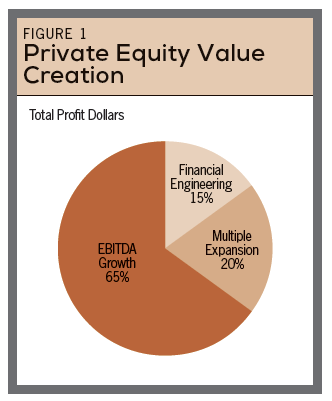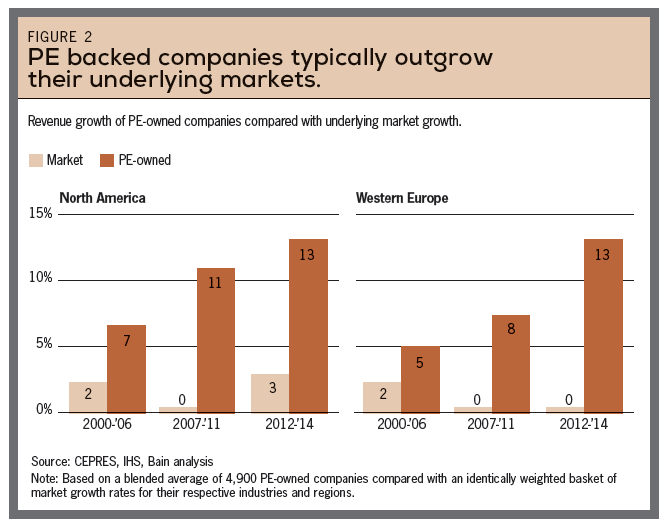As more investors look beyond the traditional 60/40 stock/bond portfolio and toward private markets for investment opportunities, a key question arises: How do alternative investment managers create value? It is clear from historical returns that they do; according to Cambridge Associates, private equity had outperformed major public indices by at least 300 basis points (3%) over 10; 15- and 20-year periods on a net basis as of December 31, 2015. But the ways private equity and venture capital funds add value to their portfolio companies differ significantly, reflecting the differing stages of the corporate life cycle at which they invest.
Private Equity
As shown in Figure 1, private equity creates value in three key ways: First, it optimizes the capital structure with leverage or debt restructuring, also known as “financial engineering.” Second, it makes operational improvements in a company, both with growth initiatives and cost cutting. And third, it offers a “multiple expansion,” allowing a company to be sold at a higher revenue or EBITDA multiple than the one at which it was acquired.

Multiple expansion is difficult to accurately time and cannot be viewed as a reliable value creation lever because it is largely outside the control of the fund manager. It is also worth noting that debt restructuring and financial engineering are no longer proprietary value creation levers for PE firms as they were when junk bonds and inexpensive debt first emerged in the 1980s.
This has forced the industry to focus on operational improvement, which generally manifests as earnings or EBITDA growth, as the primary method of value creation. Many PE firms now have operating partners and professionals with industry expertise involved at each stage of the deal process, from target identification to post-acquisition management, so cost-cutting and growth initiatives can be thoroughly evaluated and planned before an acquisition. Some have even developed in-house consulting arms and portfolios of former CEOs to help run acquired companies, such as Bain Capital’s Portfolio Group and Cerberus’s Operations and Advisory Company. More than 900 operating partners now work in the industry globally, according to a May 4, 2015, story by the Financial Times, a near-doubling from 2013 to 2015.
This value creation tool kit has allowed PE-backed companies to significantly outperform their underlying industries’ boom and bust periods over the past 15 years, as shown in Figure 2. A recent Bain analysis examined thousands of PE-owned operating companies and found that there has been a steady and significant increase in the average compound annual growth rate (CAGR) of their EBITDA since the financial crisis. Furthermore, the study found that the companies’ increase in valuation was driven more by EBITDA growth than in prior years. (See “Private Equity Is Adding Value To Companies, Says CEPRES,” from Private Equity Wire, September 9, 2016.)

To see how PE firms create value in their portfolio companies, consider the way they purchased Hertz from Ford (Figure 3). In 2005, a private equity consortium led by Clayton Dubilier & Rice (CD&R) purchased Hertz for $14.9 billion, paying $2.3 billion in equity and funding the remainder of the purchase price with various forms of debt (incurred by Hertz). The transaction was a “carve-out” deal predicated on CD&R’s belief that Hertz was an overlooked “orphan” within the large and diversified Ford organization, one that would benefit from more focused attention and management.

The PE consortium maintained a significant stake in Hertz for more than seven years and undertook a number of important value creation measures during that time. Hertz’s PE owners realized that buying and selling cars would provide a significant profit cushion as well as a means to dispose of used cars in its rental fleet, and it expanded the company into this business by acquiring British Car Auctions, a specialist company selling used vehicles, in 2009. The consortium also expanded Hertz’s focus from the premium and corporate market into the leisure and value-conscious segments by acquiring Dollar Thrifty in 2012. Seeking to improve the customer experience and respond to customer concerns, Hertz introduced hybrid vehicles, added self-service kiosks to its locations, increased the number of vehicles at suburban locations during weekends and simplified the car-cleaning process to reduce the time vehicles were unavailable to customers.
In addition, CD&R cut corporate costs by outsourcing Hertz’s large in-house programming teams and security operations and by closing unprofitable off-airport branches. Finally, Hertz’s PE owners replaced the company’s CEO and instituted a performance incentive plan for management and employees. According to a World Economic Forum report, Hertz’s EBITDA increased by 57% during its private equity ownership.
Venture Capital
Venture capital firms tend to have less involvement with their portfolio companies than PE investors, though they may contribute key resources and advice to their companies to help them achieve growth. They are less involved in part because most VC investments are minority deals rather than control investments, meaning that the firms cannot force the implementation of their preferred strategy. But more broadly, VCs invest at the earliest stages of a business’s life, essentially betting on the potential of an idea and the ability of the company’s founding team to execute a business plan around that idea. So the value added by VC firms generally relates more to basic execution and business development while private equity firms deal more with operational fine-tuning.
Venture capital firms add value by making their resources and networks available to the start-ups in which they invest, thereby providing connections that can lead to new business, an augmented team or even new financing. Firms with VC backing are more likely or faster to upgrade their internal organizations, specifically with the recruitment of professional marketing and sales staffs and with the implementation of stock option plans. They also tend to bring their products to market more quickly than non-VC backed firms.
When Mark Zuckerberg dropped out of Harvard to pursue Facebook, he realized that running a business was a much different proposition than programming and reached out to Marc Andreessen for help. Andreessen would become a key advisor and investor in the company, ultimately facilitating funding by Russian firm DST Global three years later during the depths of the financial crisis, when more traditional sources of Silicon Valley financing were reluctant to invest above a certain level.
Principals Roger McNamee and Marc Bodnick of VC firm Elevation Partners helped connect Zuckerberg to Sheryl Sandberg, a highly respected operations executive who ultimately jumped from Google to become Facebook’s COO and Zuckerberg’s trusted confidante. (Bodnick is Sandberg’s brother-in-law.) As COO, Sandberg played a key role in accelerating Facebook’s ad monetization strategy, hiring over 200 people from Google in the process.
VC firm Khosla Ventures, like many of its competitors, maintains an in-house bench of operating talent that can provide advice to its entrepreneurs on key functions, including finance, HR and IT. For example, Khosla’s Irene Au, a well-known figure in the design community who formerly ran user experience for Yahoo and Google, regularly works with Khosla’s portfolio companies to help resolve their design challenges.
Conclusion
Private equity firms generally underwrite to 15% to 20% returns and aim to achieve these returns through a combination of financial engineering, multiple expansion and operational improvement. In the latter category, PE firms are as concerned with cost rationalization and increasing efficiency as they are with accelerating growth.
In contrast, for every 100 VC-funded companies, only about 1.5 hit it big as “home runs,” reflecting the dramatically different business model of venture investing, which prioritizes the identification of promising innovations and the provision of targeted support to help start-ups grow.
In both cases, it is critical to invest only with top-tier firms—those that have demonstrated a track record of operational improvement across the portfolio, and a history of astute investment selection.
Kunal Shah is senior vice president and Caroline Rasmussen is vice president of the origination and due diligence team at iCapital Network, an online alternative investments platform.